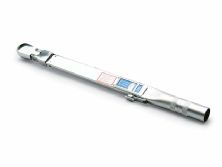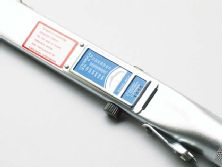People who work on cars are sometimes asked, "What is your favorite tool?" A better question is, "What is the most important tool?" My answer is a torque wrench. Tool collections usually begin with a variety of wrenches, pliers, screwdrivers, hammers, feeler gauges and other simple items. With them, an enthusiast can disassemble most components of a car, make adjustments and put many things back together. But reassembling the more sensitive components--for example, almost any part of the engine or even properly mounting a wheel-- requires a torque wrench. It ensures that fasteners apply the correct clamping force to the components they hold, neither loosening over time nor damaging parts or the fasteners themselves by over tightening. A careful mechanic is useless without one.
Most enthusiasts get by with a 1/2-in. drive torque wrench, typically covering a range from about 20 to 150 ft-lb, but a complete tool collection has both large and small torque wrenches. Many smaller fasteners' torque specs, though usually ignored, are just as important. For example, after very carefully manually tightening his cam cover nuts through the many repetitions of a large cam test, a friend was surprised to find several of the cam cover studs beginning to pull out of the aluminum head. Other small fasteners may be for rubber mounts that require just the right amount of tension to work properly. Bottom line, every fastener on a car is torqued precisely at the factory, for a reason. Working on a car correctly requires that these specs be followed. An inch-pound torque wrench is a necessity.
I recently discovered Precision Instruments. From its founding in 1938 until 2003, Precision Instruments' only customer was Snap-on Tools, for which it invented, patented and produced a variety of torque wrenches. Snap-on decided to change suppliers in 2002, and Precision Instruments invented itself as a marketing entity in order to continue in business, selling the same products and supporting users of its products already in the field. The mechanism of most click wrenches releases with a fixed amount of travel. A coil spring is preloaded to determine the load at the point release occurs. The spring will sag if left preloaded for any length of time, ruining the wrench's calibration, so the wrench must be adjusted to the minimum setting after every use.
Precision Instruments has a complete line of such wrenches, as well as dial indicator wrenches, torque screwdrivers and calibration testers, but this Tool of the Month focuses on Precision Instruments' line of split-beam click wrenches, called C series. These release at a fixed orientation of components and are adjusted by changing the amount of travel that occurs before release. When there is no torque on the wrench, there is no load on the mechanism. The benefit is that a Precision Instruments C series torque wrench can be left at any setting indefinitely without affecting its calibration. Use it and put it in a tool chest until the next use without a further thought. The adjustment mechanism is fast and requires very little force, as well as having a simple and reliable locking device. The release mechanism is essentially frictionless, so there is no need to break it in. Man-hours are saved. The only downside is that the mechanism works in only one direction, clockwise, a very, very minor point. C series wrenches are available with torque capacities from 600 in.-lb to 600 ft-lb. They are accurate within 4% of the reading from 20% of full scale to full scale. They are of all-steel construction to resist industrial and automotive chemicals as well as the general abuse that can occur in a busy work environment.
I've spent some time playing with Precision Instruments' C2FR600H wrench, which has a flex ratchet head, 3/8-in. drive and a range of 100-600 in.-lb, equal to 8.3-50 ft-lb. It's a beautifully made tool, and the convenience of adjustment helps me work faster. I also feel better lending it to close friends, knowing there's no need to worry about them adjusting it to zero after use. It comes in a durable case, so it travels well, too. I'll probably replace my less expensive 1/2-in. drive torque wrench with a Precision Instruments 40-250 ft-lb wrench when I've saved up a little. Brabus North America's chief technician had one on his bench when I visited, so it's probably good enough for Project 325.


